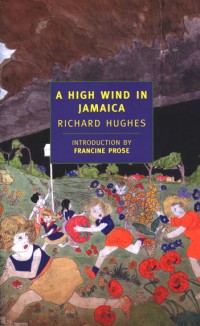25 Points: A High Wind in Jamaica
 A High Wind in Jamaica
A High Wind in Jamaica
by Richard Hughes
NYRB Classics, 1999
279 pages / $14.00 buy from NYRB or Amazon
1. On the surface, Richard Hughes’s A High Wind in Jamaica is a dot-to-dot adventure tale. After a hurricane hits an English settlement in Jamaica, two families decide to send their children back to England. Early on in the voyage the children are taken aboard a pirate ship whereupon they visit exotic ports and busy themselves with imaginary games. They are eventually returned home, and the pirates’ subsequent arrest, trial, and execution rounds out the proceedings. Of course, that last part seems a little extreme and out of place, and that’s really the book’s program, because simmering just below this surface is the constant threat of rape and murder.
2. In the spirit of Calvino’s later lecture on lightness versus weight, the narrative manages to float just above the threat of violence. You get the feeling after a while that Hughes is totally aware that you’re aware of the divide between high adventure and childhood trauma, and so he starts to fuck with your sense that awful things need to happen.
3. And, of course, awful things do happen—often and with startling frankness—but they are always quickly buried under the book’s relentless trend towards lightness.
4. The earliest memory I have is of staring up at the bottom of a kitchen table. I don’t know where I was or what I was doing, but I remember looking at a pattern in the wood and then turning toward a doorway. That’s it. I know I’ve told the memory differently over the years, adding in details about toys or sounds or maybe a smell wafting in, but the truth is that I just have this one scant moving image. I don’t think it’s a lie to embellish something so bland and colorless in texture, and at certain points I might have really believed in the additions.
5. Before I reread the novel to work on this review, I kept thinking it opened with a bigger feint at being a lighthearted adventure, but this is totally wrong. By the end of the first chapter’s scene-setting, two colonial ladies starve to death (or are fed ground-up glass by their servants, who knows!), a black servant drowns in a bathing pool, and countless rats and bats are dispatched by the family’s cat. All the while, we’re reminded that this is “a kind of paradise for English children to come to.” Right.
6. I usually skip introductions, but when I talk about AHWiJ, I almost always fall back on Francine Prose’s brief intro for the NYRB edition: “First the vague premonitory chill—familiar, seductive, unwelcome—then the syrupy aura coating the visible world, through which its colors and edges appear ever more lurid and sharp… The experience of reading Richard Hughes’s A High Wind in Jamaica…evokes the somatic sensations of falling ill, as a child.” Sign me up.
7. Another big theme of the book’s opening is the whole colonial question, which is vital and pressing and could probably be handled with greater finesse than I can muster here. Suffice it to say that the first sentence presents ruined slave quarters, sugar-grinding houses, and mansions, all “fruits of Emancipation in the West Indies.” Considering the adventure-story-through-a-fun-house-mirror about to come, it’s hard not to think that this kind of stage-setting is about just rewards, that the English family deserves everything that’s about to come.
8. A brief digression cum recipe: AHWiJ allegedly contains the first mention of a drink called the Hangman’s Blood—a mixture of rum, gin, brandy, and porter—“innocent (merely beery) as it looks, refreshing as it tastes, it has the property of increasing rather than allaying thirst, and so once it has made a breach, soon demolishes the whole fort.” Clearly the kind of mix that leads to public exposure and pissing blood and, of course, piracy.
9. Is there actually such a thing as an anti-adventure novel? (I’d imagine something like Coetzee’s Foe might come close, although its meta-narrative seems more about deconstructing the adventure genre than teasing out its hidden desires.) And furthermore, if there were such an anti-genre, would it stand in opposition to all of the finicky colonial and gender and race problems inherent in Defoe and Dumas and Stevenson? While AHWiJ is never really a wholehearted rejection of the adventure novel’s Victorian and Enlightenment-era point of view, the ways in which it represses and then inverts these views are extremely sneaky and, by the book’s end, terrifying.
10. The narrative portrays the adult world as a haze of concealed motives and consequences. A pirate’s drunken leer and a parent’s concern over a coming hurricane are met with the same curious misapprehension: that something vital or alarming is just beyond one’s young recognition. But while Hughes draws a kind of tight circular POV around the children, he also lets the reader step out into the larger circle of this adult world, and somewhere between the larger circle and the nested one is a place where motives and the threat of their attendant consequences exist. READ MORE >
November 12th, 2013 / 2:14 pm
